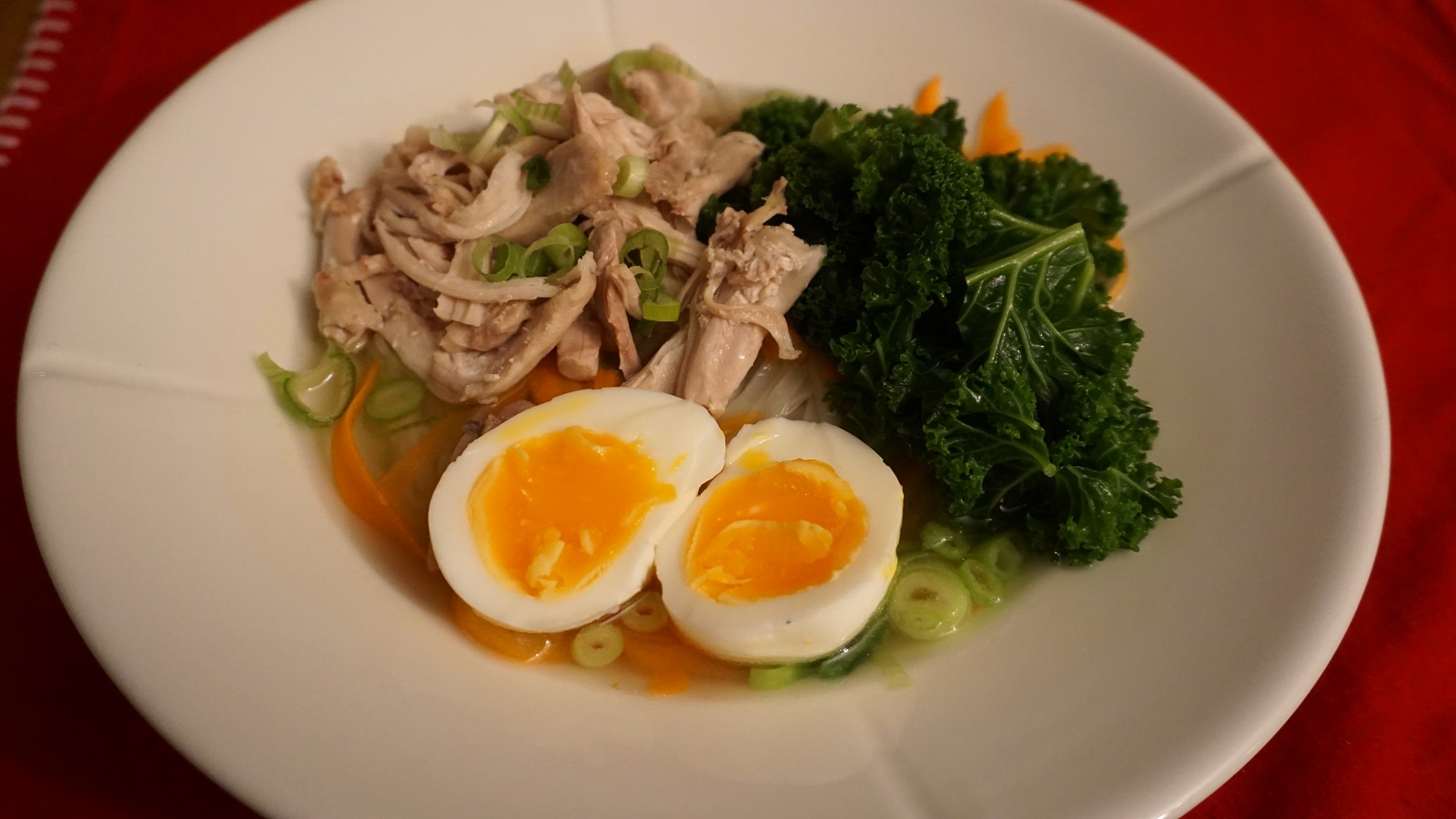This Ramen soup has a very low-calorie content
Ramen soup
Ramen soup is one of the national dishes in Japan. Although many may not know that the dish has its origins in China. There are a number of recipes, and varieties of ramen soup. The main ingredient for all types is noodles and broth. The broth can be vegetarian, based on chicken as in this recipe or other type of broth. It is relatively healthy, but this depends somewhat on what you fill it with. In this recipe, the soup is based on chicken broth, chicken, kale, eggs and Shirataki noodles. That means this soup has a very low-calorie content. Despite this, this is a soup that satisfies and still contains a lot of nutrients. The soup contains a lot of protein, few carbohydrates and little fat. On the other hand, it contains lots of vitamins and minerals. In other words, this recipe for ramen soup is a very healthy and nutritious soup. Therefore, also suitable for those who want to reduce weight. If you use regular ramen noodles, or other noodles, you increase the calorie content and the amount of carbohydrates. The recipe gives soup to 2 people.
Ingredients
Broth and chicken
600 grams of chicken legs
1 leek
150 g celery root
2 carrots
2 cloves garlic
2 cm fresh ginger
2 teaspoons whole pepper
12-15 dl water
Salt
Ramen soup
Kale
1 egg per person
Spring onions
Ready-cooked chicken
Shirataki noodles or ramen noodles
8-10 dl chicken kraft
Salt
Alternative additives
1 carrot in chopped small
2 cm fresh ginger cut into small pieces
1-2 cloves garlic cut into small pieces.
Mushroom
Directions
The broth
- Start by creating the broth that becomes the base. Have the chicken legs in a large saucepan. Fill with cold water until you have covered them with a 2-3 cm margin.
- Coarsely chop carrots leeks, celery root, garlic and ginger. Put all the vegetables in the water with the chicken.
- Bring to a boil and lower the temperature until it just simmers. Foam all impurities with a ladle or similar. Once you have skimmed off, add pepper.
- Let it all simmer for 45-60 minutes. (Simmer means that it barely boils with small bubbles). When the chicken is cooked through, you have a nice broth.
- Take out the chicken and set it aside to cool down.
- Then strain the broth into a new pot. Be sure to remove all vegetables and impurities. You can, if you wish, strain several times and let the sediment sink. Then boil the broth again, and let it boil on low heat. This means that you reduce the broth so you get a stronger taste. Reduce until you have 8-10 dl.
- Then season with salt.
You can of course alternatively buy chicken broth and ready-fried chicken. It does not give the same depth and taste, but in everyday life it can be an easy and fast option.
The soup
- Clean the chicken of skin and bones. Tear them into smaller pieces and set aside.
- Divide the kale in the right amount into to two servings. Boil it in a little salted water, and let it simmer for 3-4 minutes. Strain off all the water in a strainer or colander. Sprinkle over a little good olive oil and grind over a little salt. Set aside.
- Boil the eggs for approx. 6 minutes so that you get a soft egg yolk. Then put the eggs in cold water and let them cool completely, and then remove the shell.
- Finely chopped spring onions.
- If you want to add alternative additives, cut these into small pieces or Julienne. (Julienne means that the vegetables are cut to match size and all pieces are the same size.)
- If you use Shirataki noodles, pour them into a strainer or colander. Rinse them well in cold water. If you use regular ramen noodles or other noodles. Boil those as directed on the package. Strain and set aside.
- Now boil the broth. If necessary, add alternative vegetables and mushrooms.
- Once the broth has boiled, add the noodles in a suitable serving dish or bowl.
- Pour over the broth until it barely covers the noodles.
- Divide the egg in half. Place eggs, kale and chicken on top of the noodles. Sprinkle over some spring onions.
Serve: Immediately.
Allergy:
Gluten free. Lactose free. Low FODMAP. There is a high FODMAP in garlic and the white part of the spring onion. It is still so small that most people will tolerate it well.
NB! If you choose other types of noodles than Shirataki noodles, make sure they are gluten free, if this is important. Ordinary ramen noodles are usually not. There are other gluten-free alternative noodles than Shirataki noodles such e.g. as rice noodles.
Kale is very healthy and contains a lot of vitamins. Read more about kale. Kale
What are Shirataki Noodles. Shirataki noodles
A slightly comprehensive article about ramen soup. Ramen
